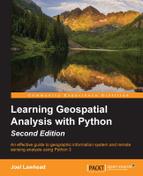Choropleth maps also show concentration, however, they use different shades of color to show concentration. This method is useful if related data spans multiple polygons. For example, in a worldwide population density map by country, many countries have disconnected polygons (for example, Hawaii is an island state of the U.S.). In this example, we'll use the Python Imaging Library (PIL) discussed in Chapter 3, The Geospatial Technology Landscape. PIL is not purely Python, but it is designed specifically for Python. We'll recreate our previous dot density example as a choropleth map. We'll calculate a density ratio for each census tract based on the number of people (population) per square kilometer and use that value to adjust the color. The dark areas are more densely populated and the lighter ones are less densely populated, as shown here:
import math
import shapefile
try:
import Image
import ImageDraw
except:
from PIL import Image, ImageDraw
def world2screen(bbox, w, h, x, y):
"""convert geospatial coordinates to pixels"""
minx,miny,maxx,maxy = bbox
xdist = maxx - minx
ydist = maxy - miny
xratio = w/xdist
yratio = h/ydist
px = int(w - ((maxx - x) * xratio))
py = int((maxy - y) * yratio)
return (px,py)
# Open our shapefile
inShp = shapefile.Reader("GIS_CensusTract_poly")
iwidth = 600
iheight = 400
# PIL Image
img = Image.new("RGB", (iwidth,iheight), (255,255,255))
# PIL Draw module for polygon fills
draw = ImageDraw.Draw(img)
# Get the population AND area index
pop_index = None
area_index = None
# Shade the census tracts
for i,f in enumerate(inShp.fields):
if f[0] == "POPULAT11":
# Account for deletion flag
pop_index = i-1
elif f[0] == "AREASQKM":
area_index = i-1
# Draw the polygons
for sr in inShp.shapeRecords():
density = sr.record[pop_index]/sr.record[area_index]
# The "weight" is a scaled value to adjust the color
# intensity based on population
weight = min(math.sqrt(density/80.0), 1.0) * 50
R = int(205 - weight)
G = int(215 - weight)
B = int(245 - weight)
pixels = []
for x,y in sr.shape.points:
(px,py) = world2screen(inShp.bbox, iwidth, iheight, x, y)
pixels.append((px,py))
draw.polygon(pixels, outline=(255,255,255), fill=(R,G,B))
img.save("choropleth.png")This script produces the following figure showing the relative density of tracks. You can adjust the color using the R, G, and B variables:

